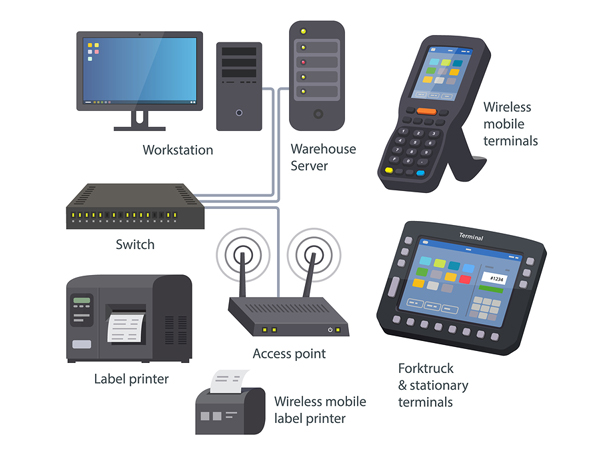If managing inventory is the lifeblood of your business, then you know that effective inventory management is vital to your company’s success, especially in today’s expanding world of omnichannel shopping and the ever-growing demand for faster merchandise deliveries. While your inventory may be a crucial asset, these assets quickly turn into liabilities when not properly managed.
In this article, we are going to cover three basic ways for businesses to make significant positive impacts on their inventory management systems.
The Current State of Inventory Management
The concept of “inventory management” as a sub-element of supply chain management (SCM) has been around for more than 20 years. But emerging trends such as cloud-based SaaS platforms, the Internet of Things (IoT) and Amazon’s next day and two-day delivery are redefining supply chain demands in a rapidly changing inventory landscape.

It doesn’t matter whether you utilize inventory in warehouses, distribution centers, manufacturing facilities, supply chain and logistics, MRO parts and equipment, field services or consignment retailing. Your operations need to be more efficient, more accurate, faster and more adaptable than ever in order to remain competitive.
New inventory management solutions are rising to the challenge, offering ways to streamline operational processes, gain warehouse efficiencies and identify cost-saving opportunities across your enterprise. Unfortunately, countless businesses still manage inventory the old-fashioned way, using pen-and-paper checklists, spreadsheets, or a homegrown database.
But manual inventory tracking is error-prone, time-intensive and opaque. Processes such as receiving, cycle counting and order fulfillment all suffer from delays, inefficient workflows and mistakes that ultimately affect customer service and satisfaction. In turn, reputation, profitability and future revenue can suffer. Since minimal data is gathered, teams can’t assess or react to changing inventory trends in real time.
So why do companies still cling to these traditional methods? There are a variety of factors. The biggest reason is usually cost, particularly for small or medium businesses that don’t have a lot of cash to throw around. Investing in an unfamiliar technology solution can be a financial risk, especially when the old way of doing things maintains a predictable status quo in terms of performance.
But while the cost of investing in new technology may seem risky at first, NOT modernizing your inventory management practices is an even greater risk in the long-run.
Improving your inventory management system doesn’t have to be a big expenditure, either. In fact, there is a broad range of solutions available which vary in complexity, implementation turnaround, the total cost of ownership (TCO) and return on investment (ROI), so you can find the right fit for your organization. A single-warehouse operation obviously has different needs than a manufacturing giant with 32 locations around the globe. Implementing a scalable solution will allow your new workflows to grow with your business, so you don’t have to find another technology solution later on down the road.
For example, the IT managed services company CyberCore achieved 99.999% data capture accuracy in their warehouse by automating their collection process.
Regardless of what technologies you select or the types of inventory you manage, there are three proven ways to optimize your inventory management workflows and make your operation more efficient:
1. Automate Your Data Collection Process
One of the best things you can do to gain tighter control over your inventory is to automate your data collection. Once your organization expands beyond a certain size, automation becomes critical to continued growth. When combined with the right mobile data collection solution, automation can help you streamline your warehouse, manufacturing or supply chain processes and deliver powerful information that unifies every aspect of your operation.
What is ADC?
Automated Data Collection, abbreviated as ADC, is an inventory management solution consisting of a combination of hardware and software technologies that work together to capture inventory data quickly, efficiently and accurately. Also known as automated data capture (ADC), automated identification and data capture (AIDC), MDC or mobile data collection (the most common term), and even just “barcoding,” ADC tracks data through a software component in the form of an Inventory Management System (IMS) or Warehouse Management System (WMS).
Data is collected through mobile computers such as barcode scanners, handheld and mobile devices, although fixed terminal systems may also be used for this process. Inventory data can then be communicated to your business software, ERP or even barcode label printers throughout your facilities.

Although both IMS and a WMS support mobile data collection, there are differences. An IMS or stock management system tends to be limited to inbound and internal inventory processes, whereas a WMS is more robust, adding internal optimization capabilities as well as outbound processes, and may be programmed to interface with specific hardware.
That’s the long answer, of course.
The short answer is, well, much shorter: automated data collection systems catalog and track inventory movements with software, which receives its data through mobile hardware devices when they scan barcodes (or perform a similar function) via mobile data collection.
This essentially eliminates the clerical busywork and manual data entry by capturing inventory data with a handheld device, such as a portable barcode scanner, and then transmitting that data to your inventory management system or WMS. When integrated with other systems like your enterprise resource planning program (ERP), these can then communicate inventory transactions in real-time across your enterprise without data degradation or loss.
It’s fast, easy, and remarkably accurate.
There are many reasons you may still be using spreadsheets or pen and paper to track your inventory. Maybe your company used to be small, but now it’s reached a size where you need to explore other options. Perhaps you inherited these traditional processes and are facing a culture resistant to change. Maybe you know there is a better way to manage your inventory but just don’t know where to go next.
Regardless of your situation, you will have the opportunity to learn the essentials as we progress through this article. These practices will help improve your inventory management performance, from warehouses and distribution centers to manufacturing and shop floor facilities.
How Do I Know When It’s Time to Automate?
You know there is a problem. You know you need a mobile data collection solution. But how do you know when it’s time to automate your data collection processes?

Here are some of the warning signs that your company needs automation to elevate operation to the next level:
You’re a Rapidly Growing Company
Your manual paper- and spreadsheet-based processes have worked up to this point but, faced with gaining newer and bigger contracts or expanding customer demand, automation is needed to keep up with the pace of growth. The bigger your operation becomes, the more inefficient these slow, error-prone processes will become, compounding the effect of any mistakes—which may not even be detected until days, weeks or months after the fact.
A natural component of company growth involves redesigning workflows, re-evaluating existing processes and investing in new technology. Failure to adjust for business growth can have devastating consequences down the road.
Adopting a scalable solution that eliminates the unnecessary busy work and has the capability to grow with your company as business needs evolve and change is essential.
For example, organic food manufacturer Clif Bar & Company successfully automated by implemented a scalable barcoding solution throughout their rapidly growing warehouse, inventory management and manufacturing operations.
You Face Market Pressures and Infrastructure Limitations
Slow sales and declining revenue due to pressure in your market can be signs that it’s time for a change. Or maybe you simply can’t keep up with demand without hiring employees and cutting into operating costs. Even if you are limited by your company’s infrastructure, MDC can leverage existing systems, enabling you to squeeze cost out of your operations and adapt to shifts in your market shifts, while also minimizing inventory shrinkage and costly returns due to data errors.
A mobile data collection solution can also integrate with your ERP and database management systems (DBMS), allowing your teams to collect data business-wide and populate ERP and DBMS systems with real-time data.
You’ve Reached the Limits of Worker Productivity

Let’s face it. Tracking inventory with paper- or spreadsheet-based processes and manual data entry has its limits in terms of operational efficiency. Every item must be painstakingly recorded and checked. When information needs to be found, locating specific data points can be labor-intensive—if the data is ever found at all. Missing information must be recreated, re-entered, or marked off as lost.
At this point, the only way to increase throughput may be by expanding the size of your workforce. Or is it?
Automating repetitive steps and eliminating wasteful tasks, through solutions like MDC, can drastically increase worker productivity and potentially save your organizations a bundle. If you’re a medium or large operation, this savings could represent millions of dollars.
For example, data automation enabled this water-distribution products company to slash time spent identifying and recording scrap by more than 92-percent per week, letting them effectively redeploy staff.
Your Data Analytics Don’t Inform Future Decisions
Not only has the amount of data we collect and transmit grown exponentially over the past few decades, but the importance of leveraging that data to inform better business decisions has never been greater. Data analytics is so critical to business operations in the 21st century that a vast range of software solutions have emerged specifically to help organizations gather, track and analyze data.
Data analytics applications take many forms, such as predictive analytics or those that address business intelligence (BI), reporting and online processing (OLAP) to more specialized analytics that cater to specific industries. An effective data analytics strategy empowers your operation with the ability to understand cycles, trends, strengths, weaknesses, and efficiency gaps down to a very fine level. Data can also be used to ensure compliance to government and regulatory agencies by supporting the ability to trace products such as food or pharmaceutical components through your supply chain within a matter of hours.
However, data analytics are only as effective as the data you collect, so naturally, you want to collect the right data both consistently and without making the day-to-day activities of your employees more difficult. That’s where automated and mobile data collection come in.
The Cost of Inefficiency Outweighs the Cost of Change
As the financial expense of technology reduces and becomes easier to implement with each passing year, the potential benefits of widely-available solutions become more attractive. Sure, change can be challenging—but the long-term cost of NOT automating can hold your organization back by acting as a barrier to growth.

Consider that workers in companies that don’t utilize automation can spend more than 27 hours per week searching, gathering and analyzing information. Add to that the significant risk (and inevitability) of errors, lost or mismanaged paperwork, and the inability to capitalize on meaningful data analytics, and you may be looking at severe inefficiencies. The more locations across your enterprise, the more these issues compound.
At this point, if a transition is ahead, consider that time and cash investments are short-term and the benefits could far outweigh the initial investment and adjustment period. If change management is a particular pain point in your organization, talk with an expert on your potential solution about how they can help you make a smooth transition.
ALSO READ: 3 Time Periods Critical to Inventory Management »
The Many Benefits of Automating Data Collection
The performance difference between manual and automated data collection is like night and day. Companies that automate their data collection processes see continuing long-term benefits, empowering your organization to become more efficient, increase the number of sales and orders fulfilled within a given time period, raise your company’s overall value, and gain a competitive edge in today’s fast-moving market. A good automated mobile data collection solution is also scalable, making it essential to growth.
Here are just a handful of the other benefits an effective automation solution can provide:
Improve Accuracy, Significantly Reduce Errors
Capturing data automatically minimizes the chance for human error, improving inventory and order accuracy. When a business relies on manual entry, there leave countless opportunities for mistakes, especially when manual information must be re-keyed multiple times or handwriting is illegible.
Increase Productivity Without Increasing Headcount

Introducing an MDC solution can help you squeeze considerable efficiency out of your existing operations without having to go on a hiring binge. The productivity gained can lead to higher throughput. Inventory coming in is processed faster while stocking, picking and packing more effectively push higher volumes of product with the same workforce since your team spends a fraction of the time performing each transaction. Innovative voice-enabled solutions provide workers the ability to handle high-volume inventory safely, accurately, and without the use of their hands.
Drive Customer Satisfaction
Accuracy and productivity both contribute to your organization’s ability to deliver the right product to customers while minimizing costly returns. With Amazon’s indisputable influence on the world of product delivery, the expectation of two-day delivery or less means it takes more to meet customer needs. Automating data collection accelerates your ability to do exactly that. In fact, this just-in-time (JIT) resupply distributor was able to improve customer service, productivity, accuracy and more.
Reduce On-Hand Inventory and Holding Expenses
Knowing exactly what inventory is on-hand, how many are being ordered, and how often these items need to be replenished is more crucial than ever. MDC supports the identification of these trends in stock control so you don’t have to spend more than is necessary holding high levels of inventory, especially if that inventory isn’t going anywhere anytime soon.
THE BOTTOM LINE: Automation Reduces Costs
Understanding how ADC affects costs with a compelling ROI and future gains can be essential to achieving buy-in when it comes time to pitch the idea to your boss or senior leadership.
Fewer errors, higher productivity, and more satisfied customers can have a huge positive impact on your bottom line, allowing your operation to get ahead and devote valuable money and resources toward other growth-oriented activities rather than just trying to keep up with current demands. The ability to forecast demand, minimize safety stock and avoid stockouts through better stock control can also create cost savings as well.
After developing a plan to automate data collection in your enterprise, your next step should be to concentrate on how these new processes can be integrated into your greater inventory management strategy and related workflows.
2. Integrate and Optimize Inventory Workflows
Having a robust inventory management system is essential ensuring future profitability. Using a combination of software, hardware, processes and best practices that work together to oversee and control stock will be key. If any of these systems aren’t connected, your IMS is in danger of losing productivity and efficiency as these areas become siloed.
Instead, focus on integrating all aspects of your inventory management and connecting these workflows with others in your business for optimal gains.
How is this done?
Implement Inventory Management Software
Automating the way you collect inventory data is only half of the inventory control puzzle. You also need to have a way to leverage that data to monitor and manage your inventory as it flows through your operation. Inventory management software sometimes referred to as inventory control software can do precisely that.

In decades past, inventory management was more of an art than a science. But software-powered automation and analytics have created new opportunities for optimization because with data we don’t have to guess. Instead, inventory management software records every transaction, thus providing the ability to leverage data into actionable intelligence, especially when integrated with other aspects of your business.
Not only that, but as far back as 2015, research by GetApp revealed that 39-percent of the individuals they polled saved five hours or more per week by implementing inventory management software. That frees up at least 260 working hours per year to focus on other, more important areas of your business.
IMS software can make an especially big impact if your operations employ a JIT methodology, where unexpected demand spikes or delays can damage your company’s reputation and push customers to look elsewhere—like your competitors. Even if you don’t engage in JIT practices, having the ability to accurately forecast required inventory levels can help you maintain lower levels of inventory and save on housing costs.
Inventory management software offers numerous other benefits as well, helping you:
- Monitor inventory levels in real-time
- Track stock movements across multiple channels and locations
- Calculate the right amount of inventory to stock
- Prevent stock-outs and order delays
- Meet customer expectations for overnight and two-day shipping
- Track clock-in and clock-out time management for employees
There are countless inventory management software platforms available today, with solutions built to manage every size of operation – from SMB to an enterprise. Many of these applications are designed specifically with the small-to-medium retail business in mind.
However, if your operation is more sophisticated, involving a warehouse, shop floor manufacturing, delivery and logistics or multiple locations, you may need a more powerful solution that is both flexible and reliable. Integration with your ERP system is essential since ERPs typically lack the transaction capabilities needed for managing inventory directly, even with an inventory module.
Cloud-based software as a service (SaaS) options can be effective, but only so long as there is a working internet connection—which isn’t always the case. Finding a solution that works in offline or high availability mode may be the answer if your team works in areas with limited connectivity.
Integrate ERP Data with Inventory Processes

The real power of implementing IMS software only emerges once that solution is integrated into your other business systems, so it can communicate with your warehouse, management or maintenance workflows. Since business management or ERP platforms often form the cornerstone of your software environment, integrate your ERP and inventory management processes to ensure that data about transactions, inventory movement and stock levels remain up-to-date.
When companies don’t connect their technology platforms, preventing data from being shared, that data becomes siloed. Data stuck in a silo can lose significant value, negatively affecting efficiency, productivity and informed decision-making.
Combined with an accurate mobile data collection solution and the right IMS or WMS, ERP integration completes an inventory management ecosystem that allows you to collect information about your items from anywhere in your supply chain and communicate that data across your enterprise. Customizing your solutions to meet your organization’s unique needs will lend further functionality to an already robust system.
The rise of Global Data Synchronization Network (GDSN) standards will make integrated data systems even more critical to beating out the competition. GDSN allows members of a supply chain (such as retailer or supplier) to update their database, which in turn updates the database of other supply chain partners. New technologies, like blockchain, make multi-directional data flows more attractive than ever.
Use Track and Trace to Enhance Visibility
Old-fashioned manual inventory tracking practices prevent you from having a true picture of stock levels and movement. An opaque system like this also obscures areas for improvement. Rather, investing in internal visibility can help you leverage the maximum amount of business intelligence from your enterprise. Increasing inventory visibility doesn’t only drive gains in efficiency, productivity and cost savings, but helps create new business opportunities, especially if that visibility extends end-to-end throughout your supply chain.
For certain industries, such as aerospace and defense or food manufacturing, the ability to track-and-trace an individual ingredient, component, or food item is absolutely essential to ensuring government and regulatory compliance. Companies like Blue Bell Creameries must be able to meet strict guidelines that require manufacturers in the food and beverage sector to trace food ingredients and products back to any point in the supply chain within two hours.
In this case, food traceability can be critical to mitigating the damage associated with a recall. Detecting counterfeit parts is another concern, particularly for government aerospace and defense contractors.

For most business models, a combination of automated mobile data collection and inventory management software can provide the ability to track inventory in real-time as it moves through your supply chain. This is accomplished by recording new information about a given item at key points in its overall flow (such as in receiving, picking, shipping, etc.) by scanning a barcode, RFID, or similar technologies. Each scan updates your database in real-time. When deployed across your enterprise, your operation can achieve complete end-to-end visibility.
Additional solutions like License Plating enable companies to intelligently bundle, manage and track groups of items as a single unit. This particular method for grouping and managing inventory by container makes receiving, shop floor staging, warehouse picking and shipping faster and easier. For process manufacturers, License Plating offers the ability to quickly locate inventory by lot for audits and recalls.
Optimize Warehouse Workflows

Amazon stands out as the top innovator in this area for its creative warehouse strategies, even if that meant disrupting the status quo with new and unconventional tactics for uncovering hidden efficiencies. By simply redefining internal best practices, retail giant Amazon has been able to drive incredible efficiency while simultaneously creating significant value.
For the rest of us, there are several other more practical trends in warehouse automation that are key to unlocking the next level of warehouse efficiency. The most important of these trends may be implementing a warehouse management system that complements your inventory best practices. A WMS shares many of the same benefits as MDC but also delivers additional strategic benefits:
- Enhanced tracking and reporting of key warehouse metrics
- Route optimization for employee pick paths
- More efficient space utilization
- Lower cycle times
- Increased inventory visibility
- Faster picking and fulfillment
- Ability to meet the special demands of customers
A WMS also helps you plan your warehouse layout for better utilization, locating higher-volume items in easy-to-access places, directing picking and put away paths to maximize the efficiency of worker movements, and enforcing warehouse quality rules that keep items from expiring or becoming obsolete, such as for first-in, first-out (FIFO) methodologies.
WMS solutions are so effective that a 2017 survey by Peerless Research Group revealed that 58% of companies planned to increase spending on WMS and ERP—the highest spending indicator between 2013-2017.
While a traditional full WMS offers significant, broad-reaching functionality, it is also very complex and may be too time- and cost-intensive for many SMB enterprises. A full WMS requires a daunting commitment to long implementation, complicated rollout and expensive long-term development support. In fact, a failed WMS implementation can even have negative consequences, particularly if that solution was a poor fit for your operation.
A simpler “WMS Light” or “Lite” alternative may be a smarter option. Cheaper, faster and easier to deploy than a full WMS, the risk is lower and offers a potentially better ROI without compromising functionality. For example, the RFgen Warehouse Director Solution for Oracle’s JD Edwards facilitates the most commonly needed warehouse functions such as inventory control, receiving, order fulfillment, directed picking and put away.
3. Don’t Overlook Remote Areas and Inventory in the Field
Effectively managing inventory in fringe areas such as remote warehouses and the field ensures an accurate, real-time picture of inventory levels and workflows across the enterprise.
With so many organizations operating with manufacturing and warehouse areas linked across multiple locations, outsources, or around the globe, it’s easy to overlook inventory flowing through satellite areas such as remote warehouses and out in the field. This is especially true when your organization operates around the clock or is growing rapidly.
Just keeping warehouse locations self-sufficient can be a challenge—most require a team of employees, equipment, robotics, and at least one IT support staff. Going above and beyond that to track inventory in real-time can be difficult and expensive, especially when that inventory flows through remote or off-shore locations or during periods of limited or volatile connectivity. Inventory on trucks can be even more problematic since they may be moving between locations or over long distances. Consignment inventory presents additional complications as well.
With so many factors to keep in mind, staying profitable requires steps to effectively manage inventory in remote warehouses and the field with the right software and hardware. These solutions not only have to manage inventory effectively, efficiently and accurately but must be able to communicate relevant data to other software systems within your operational environment.
But don’t worry. We have a few tips to help you rein in your inventory in these satellite areas:
Implement the Right Software Solution
As mentioned previously, the goal here is to find an inventory solution that is scalable, that doesn’t require significant expansion to your workforce, and that communicates between your organization’s many moving parts without incurring an excessive cost.
A few key factors to consider when researching a new inventory management solution to manage remote areas and inventory in the field:
Is the solution a right-size fit?
While you want to find a software solution that is robust and flexible enough to get the job done, you don’t want to take on a solution that is so complex or expensive that it becomes prohibitive to deploy and use in remote areas. For instance, a smaller organization may not require a full WMS when a WMS-Lite solution will fulfill your needs but without the extra headaches.

Will the solution integrate with other systems, such as your ERP or field service management tools?
Having a way to track inventory may not be enough. You also need a way for that inventory system to communicate data to and from other software systems in your digital framework, such as your Field Service platform or ERP. Without the ability to transact between software systems, inventory data that is collected loses integrity and is in danger of becoming siloed—and possibly useless. Look for a solution that integrates seamlessly with other layers in your software environment without impacting the performance of your ERP server.
Your solution should be capable of connecting with systems like:
- Vendor managed inventory (VMI)
- Remote or consignment inventory management
- Vendor receipt via advanced ship notice (ASN) or electronic data interchange (EDI)
- Logistic and transportation management systems (LMS/TMS)
- Proof of delivery or direct store delivery (DSD)
For example, RFgen helped Myers Tire Supply implement a cross-platform solution using online and offline mobile apps that integrated with several of these field service applications.
Does the solution offer a good return on investment?
Any costs associated with investing in a new inventory solution should be easy to recoup with a predictable, rewarding return on investment (ROI). For example, RFgen offers a free ROI workshop as a helpful evaluation tool.
Can the solution empower other areas of your business beyond the four walls?
The ability to automate inventory processes within the four walls isn’t much help unless you can expand those capabilities outside the four walls of the warehouse and into the field. This is the only way to achieve accurate, end-to-end visibility in your supply chain operations and inventory. Also, look for these additional capabilities as well:
- Field sales facilitation with the ability to create and sign contracts or orders, check warehouse inventory, update customer information or place orders from a mobile device.
- Plan efficient sales routes, manage truck inventory and track trucks for management.
- Delivery logistics with optimized delivery route planning, the ability to record delivers and collect digital signatures.
- Remote warehouse check-in/check-out for equipment and inventory transactions, such as receiving new inventory, put away, picking, and sending.
- Asset management with fixed asset inventory and tracking, check-in/check-out to prevent theft and loss, and the capability to record transfers between business locations.
Collect the Right Data, the Right Way
Inventory management software is only as good as the data it receives. That’s why it’s crucial to establish processes that assure data is collected quickly, accurately, in a way that communicates the relevant data to your ERP system in real-time. Without consistent real-time data collection at each remote location, the central office cannot know inventory levels and how well operations are being handled with a fine level of accuracy. Problems in these areas may persist for hours, days or even weeks before being discovered.

Automating the data collection process through a remote warehouse management solution can create a consistent overview of each location’s inventory, as well as provide the vital data capture and storage needed in the event of unexpected interruptions in connectivity. Automation can transform laborious, time-intensive manual processes into quick and easy processes that take only a few seconds and capture inventory data perfectly with the use of a handheld or mobile device.
In addition to efficiency gains in those areas, the ability to track your inventory across the enterprise, even when it’s not in the warehouse, adds up to impact the bottom line by improving overall customer service.
Be Prepared for Network Disruptions
IT professionals face major challenges in ensuring that all systems are online and running at optimum effectiveness, particularly in remote areas with connectivity issues or during critical manufacturing operations. But inventory movement, receiving and shipping are core operations that must continue even if connections to the internet or remote enterprise systems are down.
One way to address interruptions in connectivity is to have a solution designed specifically to function in offline and high availability modes. That way, your employees can continue to collect data and process jobs regardless of the connection state to your ERP or other enterprise back-end system. Off-network mobility solutions like those offered by RFgen can keep your operations running 24/7 by maintaining your workforce’s productivity regardless of your ERP system’s availability.
The RFgen High-Availability Distributed Solution provides more than a simple “store and forward” or batch operations. Rather, the warehouse software employs advanced replication techniques, intelligent queuing and tightly-coupled architecture to help reduce costs while supporting reliable 24-hour data collection. The solution handles smaller interruptions by storing data directly on mobile devices until connectivity is restored and larger outages by relying on the RFgen server until a connection with the ERP can be re-established. With High-Availability Distributed Solutions, your remote warehouses keep functioning, even when faced with unexpected interruptions from WAN outages, hardware failures, scheduled maintenance or other network disruptions.
Want to learn more about inventory management? Subscribe to The Mobile Supply Chain Blog to get new articles delivered to your inbox.






